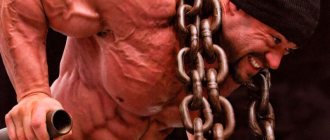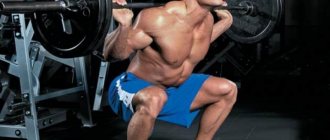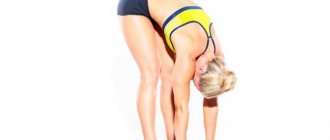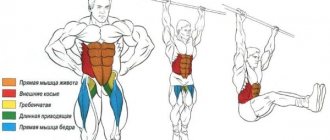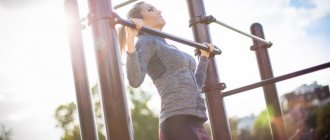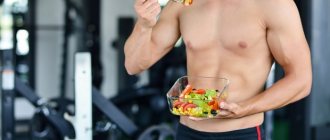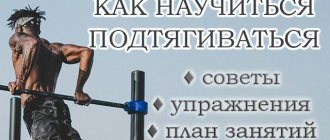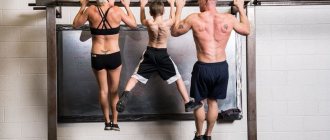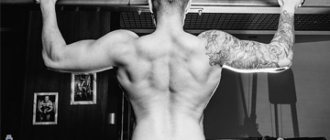The training program, which is carried out on the horizontal bar and uneven bars, is designed to strengthen the muscles of the arms, chest and back. But these same exercises have a beneficial effect on the overall tone of the body, improve the functioning of the heart, respiratory system, and endurance.
Contrary to popular belief, parallel bars training is needed not only for boys, but also for girls - it will help you look feminine and maintain a toned figure at any age.
Don't miss the most popular article in the section: Laser hair removal on the face and body - how it is done, effectiveness, before and after photos, contraindications.
Rules and recommendations for practicing on horizontal bars and uneven bars
The horizontal bar and parallel bars provide an excellent opportunity to develop the muscles of the arms, chest and back, increase overall tone and burn excess fat. It is not necessary to exercise under the guidance of a trainer. You can choose the program yourself.
For maximum efficiency, you should follow a few simple rules:
- training must be regular - only then will it give results;
- you should not overload your body - it is much more useful to perform a constant load every workout;
- The optimal load is determined by trial and error. After performing the exercises, you should still feel tired, but not so strong that it interferes with your next workout;
- the rate of exercise should be individual, even if the exercises take place in a group;
- group classes are useful to have additional motivation, but it is important to choose a group that is suitable for your level of training;
- the main criterion for choosing a set of exercises is the level of training, for most girls it is low;
- the second criterion is compliance with the chosen goal (increasing muscle mass, fighting excess weight, maintaining general tone, etc.)
Is it possible to pump up on the horizontal bar and uneven bars?
It is possible, and it is very effective. In the process of working, mice have to lift their own body weight, and this is a considerable load. If the exercises have become too easy, you can increase the number of approaches, change the height of the bars, or use special weights - they are put on your legs and increase body weight.
Exercises on parallel bars and horizontal bars are available to almost every person.
The results will be different - it all depends on the frequency of training, the characteristics of the regime and natural data, but they will definitely be there. Therefore, if you set a goal to pump up, then it will be achieved with due diligence.
In addition, training on the uneven bars improves the tone of not only the muscles of the upper body, but also the abs, back and partly the legs (you can perform additional exercises for them, we will talk about them later), so regular training on the horizontal bar will help harmoniously develop the body.
Efficiency
When creating an exercise program, many people pay attention to efficiency. What results and over what period of time can be achieved when performing a workout?
When considering this issue, we note the following nuances:
- do workouts
3-4 days a week. - The number of approaches
should be about 4. The number of repetitions should be maximum. - It is important to pay attention
to the correct execution of each movement. To do this, you should invite a friend with you who will observe the technique or perform training on the uneven bars located near the glass. - The result
depends not only on the exercises themselves, but also on rest.
Advantages and disadvantages of training on the horizontal bar and uneven bars
The horizontal bar remains extremely popular among lovers of a sports lifestyle. Recently, a separate direction for performing tricks on the horizontal bar and uneven bars has emerged. This is due to its accessibility - you can find a horizontal bar in any yard, and if you don’t want to go outside, you can put a horizontal bar at home, securing it in the doorway.
The parallel bars are somewhat more difficult, but they can also be found in parks or on outdoor sports grounds. There is no need to buy additional equipment, so training on the uneven bars and horizontal bar requires virtually no financial costs. The second advantage is the simplicity and simultaneous variety of exercises on the horizontal bar.
You can choose a program for yourself, without consulting a trainer, while harmoniously developing all the muscles of the body. Exercising on parallel bars is safe - a person would rather not be able to do the exercise at all than do it incorrectly and get injured, so such exercises can be recommended for beginners.
But besides the advantages, there are also disadvantages that are directly related to the advantages. You can exercise in the yard only in good weather, but in winter and in the rain you will have to spend money on a gym or give up training.
The exercises are quite difficult for beginners.
If we are talking about girls, then among them there are many who will not be able to complete the exercises the first time, and this repels them from such activities and destroys motivation. If classes take place in a group, then people with poor preparation find themselves “in the back”, it is most difficult for them to study, and they leave the group. But any group classes have this disadvantage.
Types of grips
There is often debate among athletes about how to properly hold on the horizontal bar. In fact, there is no correct grip - all possible options are necessary and useful, but the load is distributed differently.
Types of grips for the horizontal bar:
- Straight - both hands point the fingers away from the athlete's face. Reduced load on the forearm muscles.
- Reverse – hands with fingers facing the athlete’s face. The load on the forearm muscles increases.
- Opposite – one hand is held with a direct grip, the other with a reverse grip. The result is an uneven load on the forearms. Be sure to change hands.
- Narrow - the distance between the arms is less than shoulder width. It can be direct, reverse or opposite. Increases the load on the shoulder muscles.
- Parallel – hands shoulder-width apart. The load falls on the arms, shoulder girdle, back and chest.
- Wide – arms wider than shoulders. The main load falls on the back, chest and shoulder girdle.
- Lock – hands are clasped together around the bar.
For parallel bars, only a straight grip is possible - it is impossible to perform exercises on them in any other combination. The distance between the parallel bars can be changed to adjust the difficulty of the exercises.
From hanging lying on the floor, turn to the right to sit on the thigh.
From a hanging position, grab it with your right hand crosswise under your left reverse grip. Turning to the right and pressing the pole with your right hand, spread your legs apart and sit on your right thigh. Lowering your left arm to the side, take your left leg further back and bend your right leg at the hip and knee joint. When finishing your sit, bend over and raise your head. Training: a) from a squat on the lower pole (on a beam), perform a turn into a squat on the hip. Take and remember the correct pose; b) while hanging while lying down with a grip on the lower leg, learn to intercept with your right hand crosswise under your left reverse grip; c) complete the main element. Insurance and assistance. The teacher stands behind and supports the back.
Mode and frequency of classes
A training program on the horizontal bar and uneven bars is effective only when the training rules are followed.
The structure of each lesson looks like this:
- warm-up with an emphasis on the shoulder girdle and arm joints;
- performing exercises in several approaches;
- between approaches – exercises for other muscle groups;
- after completing the complex - exercises to restore breathing.
You can add muscle stretching exercises to the complex. Beginners can limit themselves to one approach, and add others as possible. The frequency of training depends on the goal.
To build muscle mass, you should exercise according to the 1+1 scheme, i.e. 1st day – active loads, the next – rest.
During rest, active growth of muscle tissue occurs. Then you can complicate the scheme by doing several training days in a row. To maintain tone, daily low-intensity exercise is important. They will not add muscle mass, but will allow you to maintain a toned shape.
What muscles are involved?
To know how to pump up on the uneven bars, you need to have an idea of what muscles work when doing push-ups on the uneven bars. The triceps and chest muscles are primarily involved here. The emphasis on working out certain muscles can be shifted by adjusting the execution technique. The anterior deltas and stabilizer muscles are also actively involved in the work.
What muscles work during dips?
Exercises using the described projectile are extremely effective for gaining muscle mass and increasing endurance. To the question “How long does it take to build muscles on the uneven bars?” There is no definite answer - it all depends on your initial data and intensity of training.
Common mistakes
Exercises on the horizontal bar have their own difficulties that need to be taken into account when practicing.
The table shows common mistakes and rules that will help you avoid them:
| Proper execution | Errors | |
| Breath | Inhale in the starting position, exhale at the moment of greatest load | Voluntary breathing. The athlete gets tired faster and performs fewer approaches |
| Hand movements | Smooth, elbows do not fully extend | Sudden movements and full extension of the elbows increase the risk of injury |
| Movements of muscles not involved in the exercise | The neck is completely relaxed, the legs and abs are tensed only when the exercise technique requires it. | Tension of “extra” muscles reduces the effectiveness of the main load |
| Using weights | Only experienced athletes use weights. | Switching to weight training too early increases the risk of injury and accelerates fatigue. |
Vault
A vault jump is a jump using additional support for pushing off with your hands. Vaults are included in the program of men's and women's artistic gymnastics competitions.
When performing a jump, the gymnast runs up, then pushes off using a spring bridge, makes a jump and makes an additional push off with his hands from a special sports equipment. During the jump, the athlete performs acrobatic elements (somersaults, pirouettes, spins, etc.).
Judges evaluate the complexity of acrobatic elements. Particular attention is paid to landing. A fall or even an unsteady landing will lead to a sharp decrease in the score. In the Olympic finals, gymnasts perform two vaults.
Until 2000, jumping exercises were performed through a gymnastics pommel horse. At the beginning of the 21st century, the evolution of sports equipment took place. Now gymnasts jump over a special apparatus - a “vaulting table” or “tongue”.
Jump table - “tongue”.
Special gymnastic apparatus for vault.
Women's set of exercises on the horizontal bar and uneven bars
The training program on the horizontal bar and uneven bars for girls is not fundamentally different from that for men. The main difference is that girls are usually less trained, and they have to start training with light loads and light exercises, which boys do at school. But over time, girls achieve results no worse than boys.
Warm-up
Be sure to start your workout with a warm-up - it allows you to prepare the muscles, circulatory and respiratory systems for active work, and reduces the likelihood of injuries. Warm-up duration is 5-10 minutes. It includes exercises for the neck, shoulder girdle, hands, lower back and legs.
Particular attention should be paid to the arms and shoulder girdle, and the warm-up should include rotation in the shoulders, including in opposite directions, warm-up of the wrist joints and elbows.
Chest exercises
Exercises for the chest and back muscles can increase arm strength and create muscle definition. Contrary to popular belief, pumped up shoulder girdle muscles will not make your breasts beautiful and neat - there are no muscles in the mammary gland itself, so it will look the same as before training. You can significantly improve your appearance only with small breasts (size 1-2).
To develop the chest muscles, pull-ups with a reverse and wide grip are performed on the horizontal bar; the number of approaches depends on the level of preparation. On parallel bars, for the same purpose, they do various types of push-ups - corner, chest style, diagonal and others.
Exercises for the abs
The intensive training program on the horizontal bar and parallel bars includes exercises for the harmonious development of the whole body.
Performing abdominal exercises on such equipment involves greater efforts of the abdominal muscles - they are more difficult to perform than the usual flexion-extension of the torso on the floor, the abs work more intensely, and the result is more noticeable.
On the horizontal bar and uneven bars, similar abdominal exercises are performed - raising the knees, and then straight legs, twisting, lifting the toes to the shoulders. Knowing your own body and adequately assessing your level of fitness will help you dose the load.
Stretching
Stretching is needed to relieve muscle tension after exercise. It is performed at a calm pace, which makes it possible to restore breathing after exercise. Also, girls have the belief that if you stretch, the muscles will not grow too quickly, they will form a relief, but will not be too voluminous, and will retain a feminine appearance.
The main exercises for stretching the arms are to extend the straight arm to the opposite shoulder and place the arm bent at the elbow behind the head. With your free hand you need to pull your arm towards the body in the first case and down in the second. Stretching exercises must be performed very carefully so as not to damage the ligaments and joints.
From a hanging position, squatting on a low rise with a flip at point-blank range.
From a hanging position, squat on your left side, bending your arms, and take your right leg back. With a swing of the right hand and a push of the left (without straightening the arms), quickly connect the legs and, energetically directing them up and back around the v/g, go straight out bending over (Fig. 125). Training: a) repeat the lift with a flip at point-blank range with a push of one and a swing of the other on the ground; b) from a hanging position, crouching (legs rest on a raised platform of 4-5 mats) lifting by turning over at point-blank range (with a push of one and a swing of the other) on the floor. Pay attention to the full straightening of the pushing leg; c) performing the main element (with help and independently). Insurance and assistance. The teacher stands on the side and helps with one hand under the pelvis, and with the other under the shoulder, and when going to the point-blank range - from below under the legs.
From the emphasis on the v/g, lowering forward into a hanging position while lying on the v/z.
From the emphasis on the chest, bend over (creating a slight rotation of your legs back), and then, tilting your head forward and bending your arms, tilt your torso forward. Continuing to bend at the hip joints and roll forward, lower the pelvis, sliding your legs along the i/z. Next, straightening your arms and straightening your hip joints, lower your legs onto your lower back and take a lying down hanging position. Training: a) from an emphasis on the lower body, lowering forward into a hanging position on a pile of mats; b) from the emphasis on the v/g, lowering forward into a hanging position while lying on the v/z. Insurance and assistance. The belayer stands on the side, supporting the student with one hand under the shoulder and the other under the thigh.
Training plan
The training program on the horizontal bar and uneven bars is compiled individually for each student. For a beginner, the best option is to exercise every evening to keep fit or according to the 1+1 scheme to build mass. The plan for each lesson should include a warm-up, 3 exercises on the horizontal bar or parallel bars, stretching and breathing restoration.
Before you create a training plan, you need to decide on your goal and select exercises that will correspond to it. If the goal is to maintain athletic shape, then it is better to take 3 exercises for different muscle groups (chest, arms, abs) and perform the same complex every day.
If the goal is to gain muscle mass, then you should select 3 exercises for each muscle group and alternate them (arm day, chest day, abs day). It is convenient to divide exercises on the horizontal bar and parallel bars into different days. If the training plan is drawn up correctly, the result becomes visible within a month even for those who are not very physically fit.
The main thing is regularity of classes and proper execution of exercises . If the result is not satisfactory, then the lesson plan can and should be changed, adapting to individual characteristics. As an example, you can find ready-made training plans on the Internet, but you need to be prepared for the fact that they may suit some people, while others will have to modify them.
Features of the projectile
Gymnastic bars are suitable for everyone - small children, teenagers, adults, because the load comes solely from their own weight, and the hands must be trained in relation to the size of the body. If we are talking about comfortable and useful exercises in gymnastics, the width of the parallel bars must correspond to the age, which means you will have to either make them for a specific person, or simply practice on the parallel bars, because their width is adjustable. The distance between the parallel bars should be several centimeters wider than the shoulders; a larger distance can be traumatic, and a smaller distance will overload one muscle group, namely the triceps. So adjust the gymnastics bars so that they are comfortable, you need to tighten them so that they do not wobble or sway.
The best exercises on the horizontal bar for girls
It is better for girls to start classes with fairly simple exercises - this will help adapt to physical activity and improve the overall tone of the body. Even if a girl can’t or doesn’t want to pump up her body, exercising on the horizontal bar will have a beneficial effect on her physical fitness, allowing her to shed extra pounds and create an ideal, toned figure.
Vis
The hang is the simplest exercise you can do on the horizontal bar. It is not performed on uneven bars.
Performing a hang on the horizontal bar:
- the horizontal bar should be slightly higher than the height of the athlete with his arms raised (so that when hanging, it does not reach the floor);
- the correct grip is parallel or slightly wider than parallel;
- the legs can be straightened or bent at the knees, the elbows should be straight (the only exercise on the horizontal bar with straight elbows), the head tilted forward;
- the body relaxes and remains in this position for 3-4 minutes.
The hang is perfect as a starting exercise. The main task of the hang is to relax the muscles of the back, neck and arms, and straighten the spine. This helps to cope with the consequences of both a sedentary lifestyle and excessive strength loads.
Pulling your knees to your chest
This abdominal exercise is great for beginners. It is performed on the horizontal bar and uneven bars.
Technique for performing on the horizontal bar:
- starting position – hanging with slightly bent elbows;
- legs are bent at the knees, brought together, in this position they rise to chest level;
- return to the starting position.
All movements are performed smoothly, especially the return to the hang. In the initial stages of training, it will be difficult to raise your legs to the desired height, but you should try to raise your knees as close to the correct position as possible. Over time, you will be able to perform the exercise correctly. The most common mistake is trying to raise your legs with a sudden movement.
This is less effective than gentle lifts and poses a risk of damaging your elbows. On the uneven bars, the starting position looks like this - the arms support the body above the apparatus, the elbows are slightly bent. Performing abdominal exercises on parallel bars is somewhat easier, but the load on the arms is higher.
Hanging Leg Raise
Starting position – hanging on the crossbar, as in the previous exercise. The lifting process must be carried out in several stages, especially for beginners.
Sequencing:
- vis (starting position);
- raising your knees to your chest;
- straightening the legs so that the feet are higher than the crossbar (be sure to raise the pelvis);
- return to the starting position (possible through knees bent at the chest).
The exercise develops the abs and muscles of the thighs, buttocks and back. On the uneven bars it is performed by experienced athletes.
Don't miss the most popular article in the section: Morning exercises for those over 40, 50. Gymnastics exercises for weight loss, video lessons.
Hanging crunches
Twists are performed upside down. To do this, you need to hold on to the bar with your knees and flex and extend your torso. The exercise can be performed after hanging leg raises (reverse crunch) have been mastered.
Corner
Another abdominal exercise. Performed hanging on the crossbar. From this position, you need to raise your straight legs to a horizontal position so that they form a right angle with the body (hence the name of the exercise). You need to stay in this position for 10-15 seconds or more if you are training endurance. Performed on the horizontal bar and uneven bars.
Australian pull-ups
This is a simplified version of the pull-up on the bar. The crossbar is installed lower than usual, and in the initial position the body is horizontal or at an angle and touches the heels to the floor. When performing pull-ups, you need to pull your shoulders towards the bar, your face should be above it.
Training program on the horizontal bar and uneven bars for girls.
In this case, the arms do not lift the entire weight of the body, but only part of it. Over time, you need to raise the bar higher, gradually moving from Australian pull-ups to classic ones.
From the seat on the right thigh to the lower nipple, bending.
Grasp the knee near the right knee with your right hand. Transferring your body weight to your right hand, push off with your hip against the back, while simultaneously swinging your left hand up and out. Connect your legs, bend over, leaning on your right hand, and land softly. This dismount can be performed with a turn to the right in a circle, as well as to the left in a circle. In the first case, you need to grab the left hand with a reverse grip at the right knee. Transferring your body weight to your left hand and pushing off with your hip, release your right hand, turn around to the right, connect your legs and bend over. In the second case, you need to take hold of the lower body with your left hand, behind the body at the left hip. Transferring your body weight to your left hand and pushing off with your hip, turn to the left in a circle, bend over and land. Training: a) the basis of these dismounts is the feeling of good support on the hand. Before performing a dismount, we advise you to move from a seat on your hip to a lower leg with your hand (as is necessary in the exercise) and imitate the transfer of body weight to this hand without making a dismount. Teacher-performer with one hand, under the shoulder of an unsupported hand, and the other - around the waist; b) complete execution of the dismount. Insurance is the same.
From hanging, lying on the floor, circle the right with a left turn of 270° to a squat on the right thigh.
From a hanging position, lift your right leg and, turning to the left, grab your left hand with your right hand on top. Continuing the turn another 180° (the body should remain arched), push with your left hand and swing your right leg over the floor. Lowering your left arm to the side, take your left leg back, bend your right leg, bend over. Training: a) from a hanging position lying on the floor, turn to a squat on the right thigh; b) from a hanging position, lift your right leg with a grip on the left leg and perform a 180 degree turn to the left (right leg to the side), intercepting with your right hand on top of your left arm (sag at the shoulders, do not bend your arms); c) holistic, performance of the main exercise. Insurance and assistance. The teacher stands on the left (with his right hand he supports the performer under the lower back, with his left he “guides” her leg). As the turn is performed, the teacher moves back to the right and continues to support the lower back with his left hand, and the right leg with his right hand.
Training program on the horizontal bar and parallel bars for beginners
The horizontal bar and parallel bars training program for beginners includes simplified exercises. You need to start small - by doing hanging exercises every day, so that in a week you accumulate at least 30 minutes spent in a hanging position. This will relax the spine and back muscles, reducing the risk of injury in the future.
Then you can move on to pull-ups. If a person cannot do it themselves, they can start with the Australian version or have another person provide backup. Abdominal exercises are performed in the following sequence - knee lifts, leg raises and corners, crunches. At first, it is advisable that the practitioner be insured.
A daily routine for beginners may consist of hanging, pull-ups and knee raises.
Even an incompletely completed exercise strengthens the muscles and brings the day closer when the exercises will be performed correctly and it will be fashionable to move on to more complex ones.
Artistic gymnastics in the 21st century – world leaders
Continuing Soviet traditions, Russian gymnasts maintained leadership in artistic gymnastics until the end of the last century. The 21st century has changed the balance of power in this type of gymnast.
Over the last decade, the main competition has taken place between athletes from 5 countries: China, Russia, Japan, USA, England. Brazilian, German, Turkish, Greek, Italian and Korean gymnasts are also competing for medals.
Men's teams
Men's artistic gymnastics at the 2012 Olympic Games brought first place to Chinese gymnasts (3 gold medals). In 2016, the overall team standings among men's teams were led by England and Japan (2 gold medals each). In 2022, the leadership among men was shared by China and Japan (2 gold each).
At the Olympic Games in Tokyo, the Russian men's team won the most prestigious award in artistic gymnastics - Olympic gold in the team all-around. For Russia, this is the first (and so far only) gold medal in men's competitions since 2004.
The World and European Championships are turning out more successfully for Russia. The biggest success is the 2022 World Cup. The Russian men's artistic gymnast team won 3 gold medals and topped the team competition. In April 2022, Russian gymnasts once again confirmed their superiority at the European level. The last European Championship brought the Russian men's team 3 gold medals out of 6 possible, plus 4 silver.
Russian gymnasts Nikita Nagorny, Arthur Dalaloyan, David Belyavsky, Denis Ablyazin are among the strongest gymnasts of the last decade.
Women's competition
Among the women's teams, the dominance of the United States stands out. In 2012, American women won three gold medals, in 2016 four out of a possible six. Russian gymnasts bring one gold medal from each Olympics. Olympic gold for Russia at two Olympics in a row .
At the Tokyo Olympics, the main battle in women's artistic gymnastics competitions was between the United States and Russia. In 2022, American women took home 6 medals, 2 of them gold. Russian gymnasts brought home four medals (1 gold, 1 silver, 2 bronze).
Like our men, the girls won Olympic gold in the team all-around. The following climbed to the first step of the Olympic podium: Angelina Melnikova, Victoria Listunova, Vladislava Urazova, Liliya Akhaimova.
Training program on the horizontal bar and parallel bars for weight
To build muscle mass, you need intense exercise. It’s worth thinking about this when your fitness level can be called medium or high. A set of exercises is developed for each segment that needs to be pumped up.
During the workout, exercises are performed for 1-2 segments and the press. The more approaches, the better, and the duration of each approach should be no more than 8 times. The training scheme is 1+1, then 2+1 and so on. It is acceptable to work with weights for the limbs and torso.
Contraindications to classes
The main contraindication to training on the horizontal bar and uneven bars is injuries to the arms and shoulder girdle (joints, bones, ligaments, muscles). It is impossible to perform the exercises correctly, and it is very easy to damage an already injured area. As for diseases of the spine, you should consult a doctor.
General recommendations in this case:
- scoliosis – exercises are allowed and useful;
- kyphosis - straight grip only, weights preferably;
- lordosis – back arching is contraindicated;
- osteochondrosis – feasible training, only a smooth descent from the horizontal bar;
- intervertebral hernia is an absolute contraindication;
- the consequences of a spinal fracture are usually a contraindication.
Caution should be exercised in diseases of the bones, cerebral vessels and intercostal neuralgia. The training program on the horizontal bar or uneven bars can be selected for any level of fitness. For beginners, you can start with hanging, and experienced athletes can choose a complex set of exercises that work individual muscle bundles.
Article design: Anna Vinnitskaya
